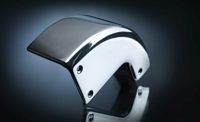An international team of physicians and medical device engineers made medical history in October 2015 when they successfully designed, manufactured and implanted a titanium sternum and rib cage in a person for the first time.
The groundbreaking surgery was performed at Salamanca University Hospital in Salamanca, Spain. The patient, a 54-year-old man, had lost his sternum and some of his rib cage to cancer. While he might have survived without the bones, his quality of life would have been diminished and he would have been vulnerable to injury. However, replacing the bones with prosthetics would not be easy. That part of the chest is difficult to recreate due to the complex geometry of the bones and the unique size and shape of each person.
Engineers at medical device manufacturer Anatomics in Melbourne, Australia, solved the problem by tapping an additive manufacturing technology called electron beam melting (EBM). Similar to selective laser sintering, EBM creates parts by melting metal powder layer by layer with a high-energy beam of electrons.
The metal powder for EBM is usually a pure alloy (no additional filler material is needed). Different titanium alloys, as well as cobalt-chrome, are the most commonly used metals for EBM.
The EBM process begins with a layer of metal powder placed on a temperature-controlled print platform. The print chamber is vacuum-sealed to minimize any effect of oxidation on the material. Then, the electron beam, directed by electromagnetic coils, melts a cross-sectional area of the object to complete the first layer. (Depending on the size of the parts and the print platform, multiple parts can be created simultaneously.)
Once the layer is complete, an automated roller spreads a fresh coat of powder on top of the previous melted layer. The process then repeats until a complete 3D object is formed.
EBM is used for high-stress aerospace applications and medical grade implants. The technique produces objects that do not require additional heat treatment to achieve the full mechanical properties of the alloy. Due to the high temperature of the process, EBM produces parts with solid densities and little to no internal stresses.
To create the patient’s new sternum and rib cage, Anatomics engineers began with high-resolution computerized tomography (CT) scans of his chest. A CT scan combines a series of X-ray images taken from different angles and uses computer processing to create cross-sectional images, or slices, of bones and soft tissues inside the body. Data from the CT scans was then used to create a digital 3D model of the man’s rib cage.
“From this, we were able to design an implant with a rigid sternal core and semi-flexible titanium rods to act as prosthetic ribs attached to the sternum,” explains Anatomics CEO Andrew Batty.
The team then manufactured the implant out of surgical-grade titanium alloy using an EBM system from Swedish manufacturer Arcam AB.
“We wanted to 3D print the implant from titanium because of its complex geometry and design,” Batty says. “While titanium implants have previously been used in chest surgery, designs have not considered the issues surrounding long-term fixation. Flat and plate implants rely on screws for rigid fixation. Those screws may come loose over time. This can increase the risk of complications and the possibility [that the patient would need surgery again.]”
Both the surgeons and the patient are pleased with the outcome. “The operation was very successful,” says José Aranda, MD, one of the physicians who performed the surgery. “Thanks to 3D printing…we were able to create a body part that was fully customized and [fit the patient] like a glove.”



